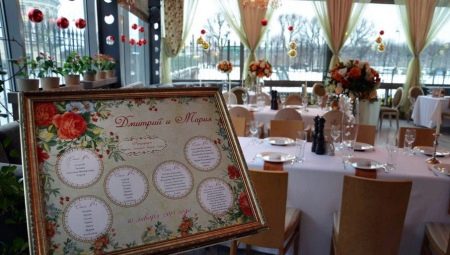The seating of guests at the wedding table is an important organizational moment. The psychological comfort of the guests and the general mood of the holiday depend on a correctly drawn up seating plan. Therefore, this event is given the closest attention, and at the same time all sorts of related factors are taken into account.
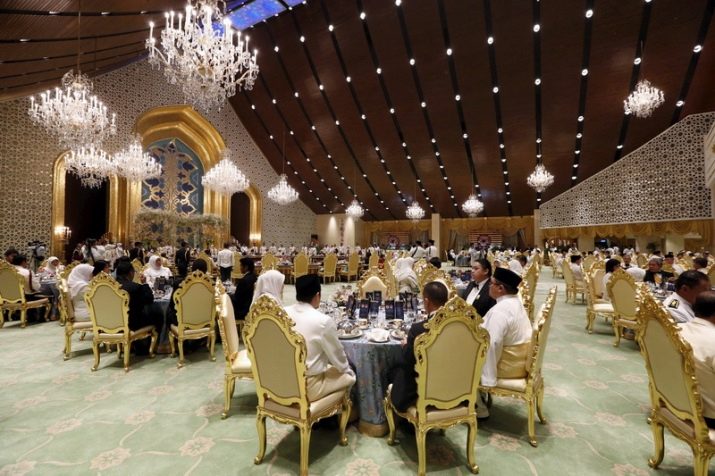
The main types and layouts of tables
Before you begin planning and make a plan for seating the guests, you should decide on the location of the holiday tables. There are many options here, and which one to choose depends on the number of guests, the size of the banquet hall and the personal preferences of the groom and the bride. First of all, it is necessary to examine the venue of the future banquet and draw up an accurate floor plan. It is desirable to display the differences in floor heights, the location of windows, doors and a DJ table, as well as the presence of columns, their location and number.
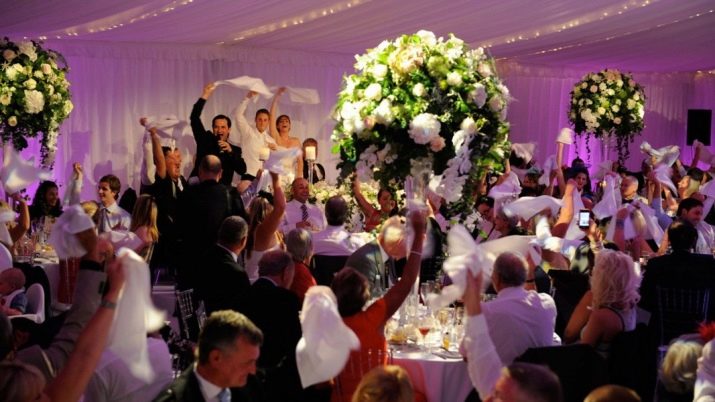

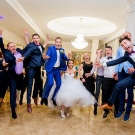
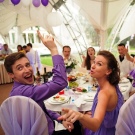
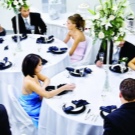
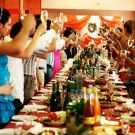
You should also ask the staff of the institution what shape and size the tables will be, and whether the administration allows them to be moved. This is due to the fact that in some cafes and restaurants tables are already arranged taking into account the architectural design of the room and the convenience of the attendants and it is not allowed to rearrange them. If the manager of the institution is not opposed to moving the tables, then you can begin to choose the layout of their location. Below are the most popular location options. among which there are both traditional options, and fairly new, and sometimes unexpected.
- The classic scheme. This method is considered the simplest and is used at banquets with a limited number of guests. The hall has one long table, made up of several small tables adjacent to each other. The heroes of the occasion are always seated at the head, with the young spouse seated to the right of her husband, and on both sides of the newlyweds are their witnesses and parents. When seating guests at a common table, a traditional scheme is used, in which men and women alternate.
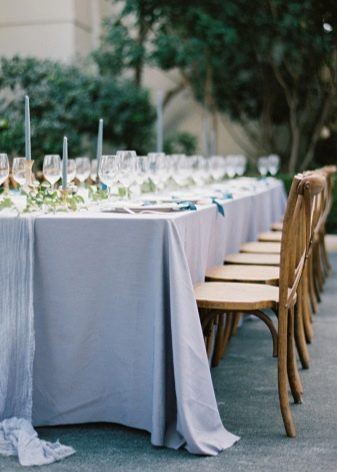
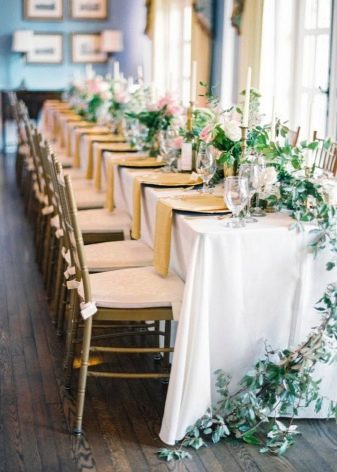
- T-way table layout has long been the most common option. This arrangement is perfectly suited for ceremonial banquets for up to 25 people, held in small halls. The bride and groom sit at the head of the table, followed by witnesses and parents, and the rest of the guests sit down as they like, since the T-shaped arrangement contributes to the visibility of the guests, and allows each of the guests to see and hear everyone from almost anywhere from those present.
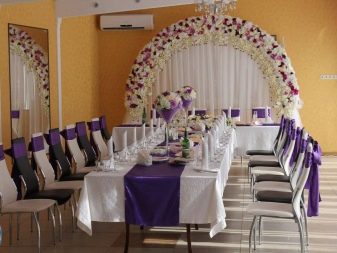
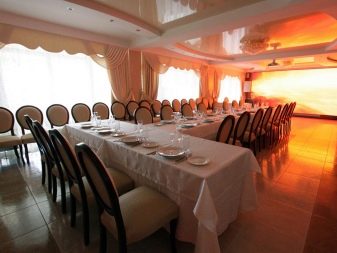
- U-shaped method table setting is suitable for more numerous weddings, where the number of guests reaches 50 people. This also includes the W-shaped arrangement, which is used in cases where the number of guests exceeds 60 people. However, with both methods of placement, you need to pay great attention to seating the guests and in no case let it go by itself. This requirement is due to the fact that a significant part of the invitees will be located with their backs to each other. This will seriously impede communication between close people who did not get a place behind one "sleeve" of the table, and will force them to eat and chat in half-turn.
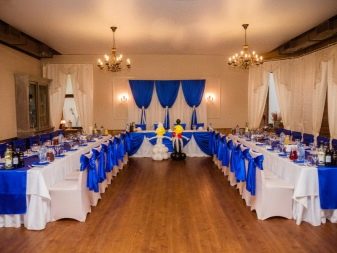
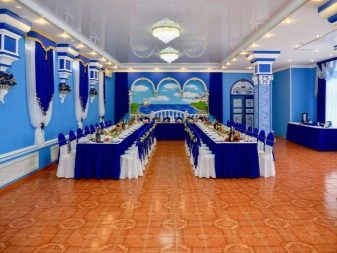
This is followed by European options for the arrangement of tables, which were quickly adopted by Russian restaurateurs and event organizers and began to be widely used for ceremonial banquets. The main feature of the European scheme is the presence of separate tables in the hall, acting as an alternative to the common table. This method is very convenient when seating people according to interests, age and degree of relationship.
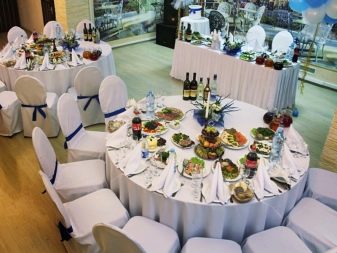
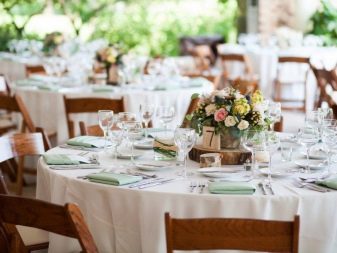
Young spouses also sit at a separate table, with witnesses and parents sitting at adjacent tables. However, this innovation, along with admirers, has opponents who argue that this arrangement makes communication between guests at adjacent tables somewhat difficult, and if they are sufficiently far from each other, it completely reduces it to nothing. In order to avoid such moments and not turn the wedding into a few completely independent and not overlapping "interest clubs", the host is invited. And if the invited organizer is truly a master of his craft, then he will skillfully and correctly be able to organize joint contests, games and quizzes and it is easy to get all the guests to know each other.
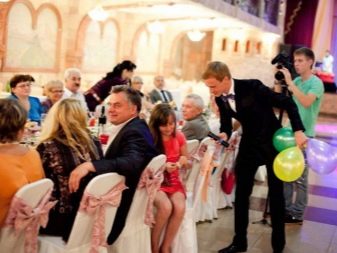

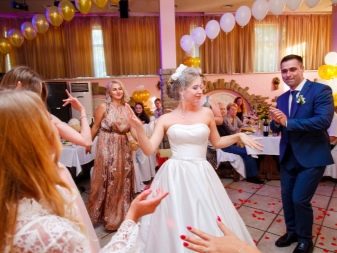
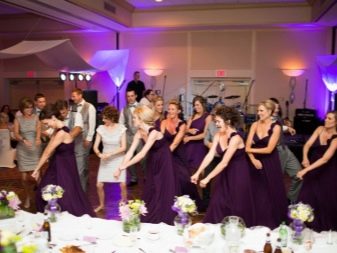
If the presence of the host toast at the event is not provided, then there are certain risks that guests sitting at separate tables will not intersect at all during the banquet and will get bored. Therefore, when choosing European placement options, the moment of communication must be taken into account.
- Italian way involves the arrangement of square tables for four people, staggered. Tables should be set up so that guests from any place can freely see the main table, at which young people will be. For a better overview, the newlyweds' table is placed on the stage or elevation, which allows them to freely communicate with the guests, and those present can see and hear the spouses well.
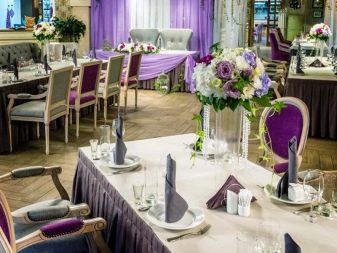

- English version involves the use of round or oval tables, for which eight people are seated.According to most European psychologists, it is precisely this number of people that is most comfortable for communicating in a narrow circle. Another interesting method also applies to the English style, in which guests are seated in such a way that none of them should have their backs to the young. To do this, chairs are placed only on one side of the tables, seating the audience in a semicircle. For the similarity with the arrangement of chairs in the institution of the same name, the method was called "cabaret".


- Christmas table setting It is an average version between European and traditional methods. In this case, young people are also seated at a separate table, and the remaining tables, usually for 8-12 people, are placed diagonally from the main one, parallel to each other. Guests with this arrangement should sit along the two long sides of the table, while the side parts remain unoccupied.
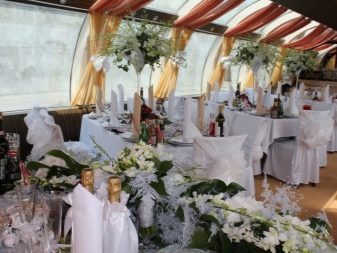
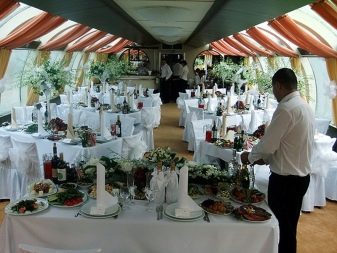
With this arrangement, the central part of the banquet hall usually remains free, turning into a place for games, competitions and dances. When arranging a "herringbone", the ends of all tables should look at the table of the newlyweds and in no case vice versa. The location at which one of the long sides of the guest table is "looking" at it is wrong.
- American way The arrangement consists in the fact that along the perimeter of the room they set up long tables with dishes located on them, and each guest comes up and chooses everything that he liked. In the center of the hall, two long tables are set up and placed parallel to each other. Guests, having taken their favorite dish, sit down at any of them and eat. At the same time, the newlyweds are seated at a separate table, perpendicular to the two guests. The advantage of the American version of the buffet is a significant reduction in the cost of products, and the disadvantages include the need for self-service, which many guests may not approve of.

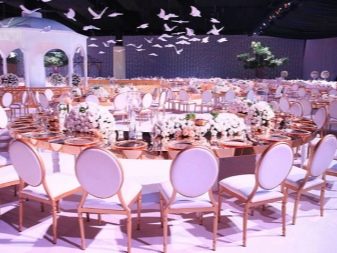
- Reception "buffet" It is used in the case when the organization of a magnificent banquet is not planned, and the couple immediately after registration leaves for a honeymoon. Under such circumstances, the ideal option would be to set up buffet tables without using chairs. The tables usually have drinks and light snacks, and the event itself resembles a short party.
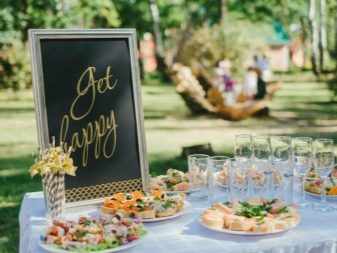
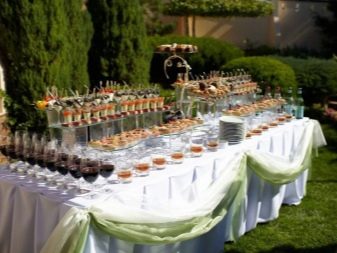
Ways to indicate places
Before you begin planning your seating arrangements, you must write a complete list of guests and send them invitations. Once the answers are received, you can begin to draw up a plan. In order to prevent confusion when seating people, and everyone quickly finds their place, a colorful stand or an easel with an image of a seating plan is placed in the lobby of the banquet hall. Cards with the names of guests and with the number of the table and the place of boarding are attached to it.
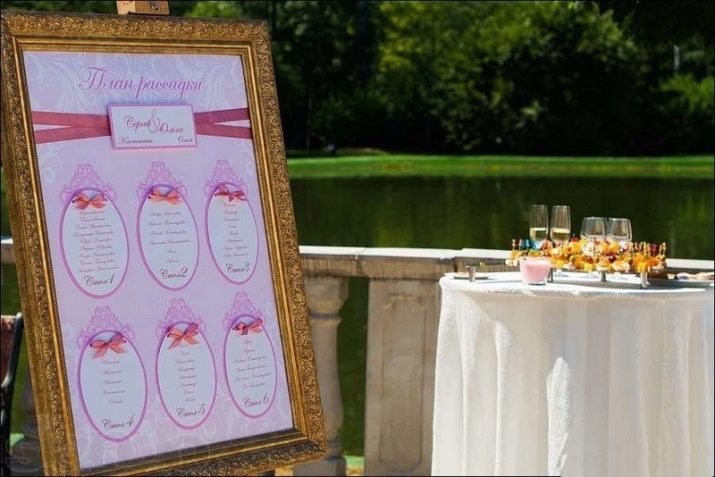
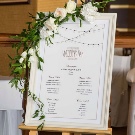

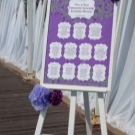
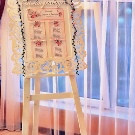

The form of the information poster and its layout must be thought out in advance, this will allow you to quickly create the necessary props and draw it beautifully. So, for weddings held in the country style, it will be appropriate to make a poster in the shape of a window and place it on a tripod. If the wedding is held in a vintage style, then you can take a stylized board and write on it with chalk all the necessary information. An interesting option would be to write the numbers of tables and guest names with a marker on a glass stand.
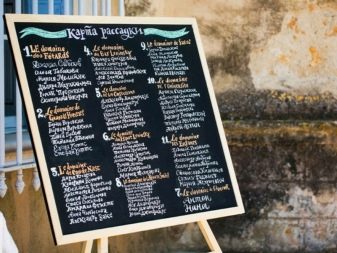
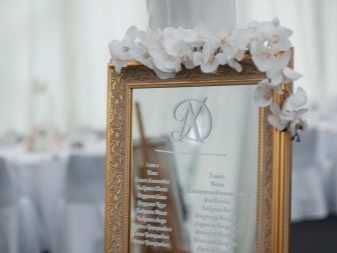

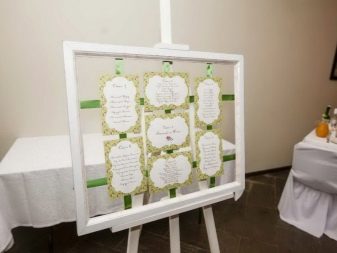
However, you can draw up an easel or poster not only with a list. It can be a beautifully drawn plan of the banquet hall. According to it, guests will easily navigate and will know which part of the room they are going to. In addition, if the tables are arranged in a European style, then each of them can be assigned its original name. Varieties of wines, names of garden flowers, precious stones, dances or shades can serve as options. If the number of invited is more than 15 people, then you need to do 2-3 identical copies and place them in different places in the hall.This will save people from having to stand in line in order to find out their place and will contribute to a quick and calm seating.
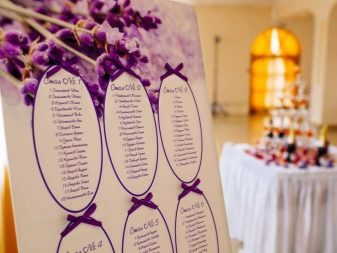
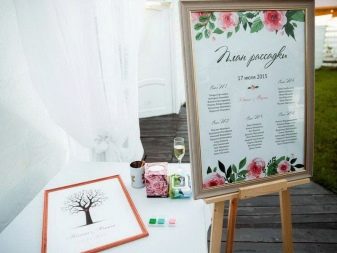
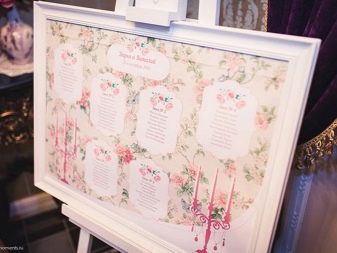
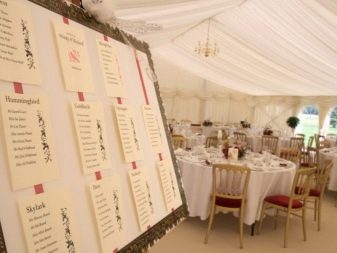
Each room on the stand has its own card with the desired number or guest name. They are placed on the tables, and the invitees easily find the right place and sit down. When creating a card layout, you need to consider that the guest’s name looks much more spectacular than faceless numbers, so it’s better to be puzzled and make them personal. In addition, these cards continue the line of the general style of the event and show guests how each of them is important for young people.
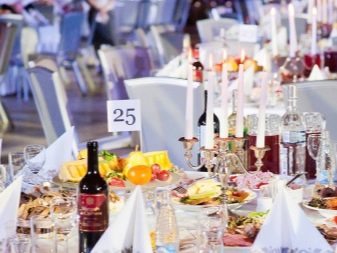
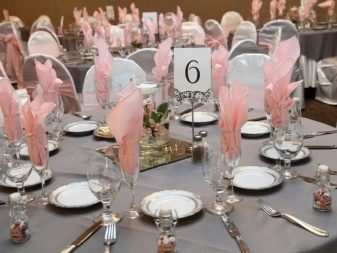


The design of cards should repeat the design of invitations and closely intertwine with the decoration of the hall and the color trends of the celebration. The names of peers are registered without indicating a middle name, while for older people it is mandatory to spell it, but it is better not to write the surname in both cases. The exception is the presence at the banquet of two or more people with the same name. In this case, the spelling of the surname is necessary.

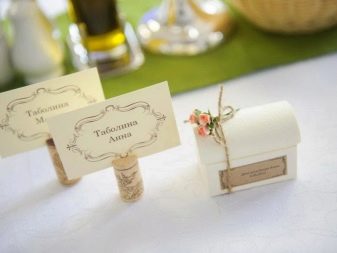
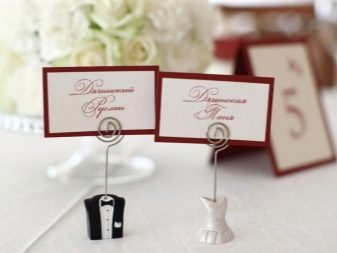
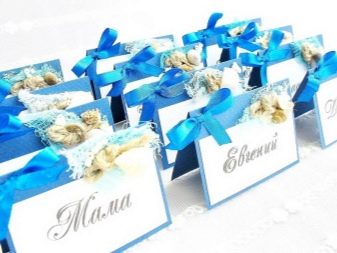
Design options
The stand with the list and name cards can be ordered at the printing house, whose specialists will help you choose the right design that matches the main style and idea of the holiday. However, printed matter, no matter how beautiful it may be, has become a little boring and especially does not impress anyone anymore, so if you have free time, it’s better to draw up the props yourself. Homemade cards look much more soulful than those printed on the printer and will be remembered for a long time by the guests of the holiday.
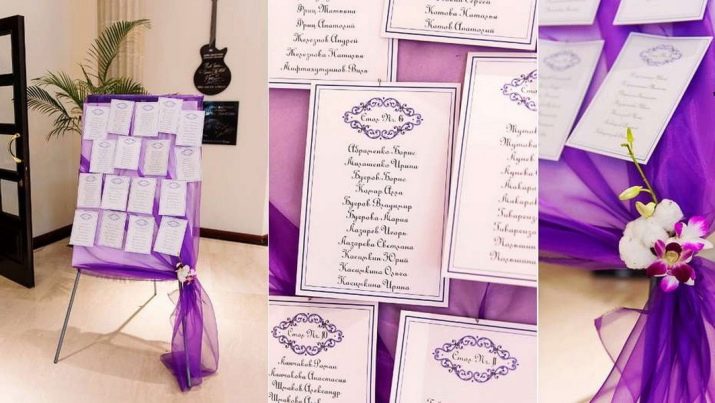
DIY manufacturing technology is as follows:
- 10x10 cm cards are cut out of cardboard and bent in half;
- on one part, a figure cut out from colored paper with the number of the seat and table is glued, and on the other, the name of the guest is written in beautiful font;
- the background of the card should match the overall color scheme of the holiday, and the numbers should be the same color spectrum, but a little darker;
- then the edges of the card are decorated with satin braid, which is tied in a bow and decorated with a bead;
- the upper left and lower right corners of both parts of the card are decorated with sequins, the main thing is that there are not too many of them, and they do not cover the number and name.
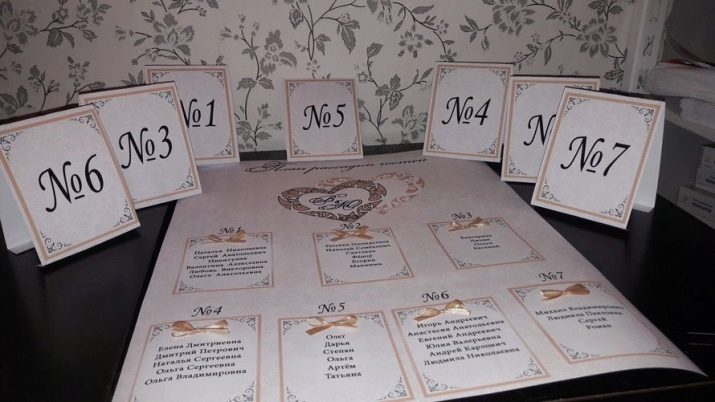
When making cards, you need to make several blank copies. This will help to quickly finish the name and seat a suddenly changed one's guest who refused an invitation earlier or a new person who came with one of the guests.
You can place cards in different ways: it can be a classic house or a heart or a circle, notched from below and worn on a wine glass. If time and money allow, then instead of a card, you can put each guest a small gift box with a name written on top and some kind of symbolic surprise inside. Origami cards, placed on plates and decorated with sweets or flowers, also look great.
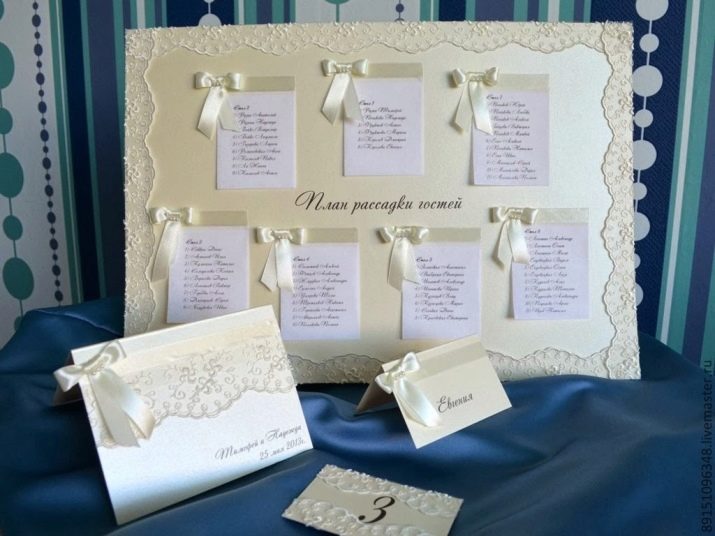
Rules and Tips for Planning
After the layout of tables and the way of indicating seats are selected, you can begin to compile a list: which of the guests will be sitting next to whom. To do this, you need to use simple recommendations, which will help to accommodate each guest as comfortably as possible, thus choosing interesting interlocutors and a pleasant company.
- With any arrangement of tables, it is desirable that all guests have the opportunity to see the heroes of the occasion.
- Parents and close relatives are seated as close as possible to the young, taking into account the age and degree of kinship of relatives.
- If a high-ranking person is present at the banquet, it is recommended that they be seated at a separate table, as close as possible to the newlyweds. Moreover, they should not be seated at the same table with their parents: this will lead to the fact that both of them will feel awkward and will not really eat anything.The best option would be to seat them next to close friends of the newlyweds. At this age, the guys still feel quite relaxed, and the presence of senior officials will not bother them.
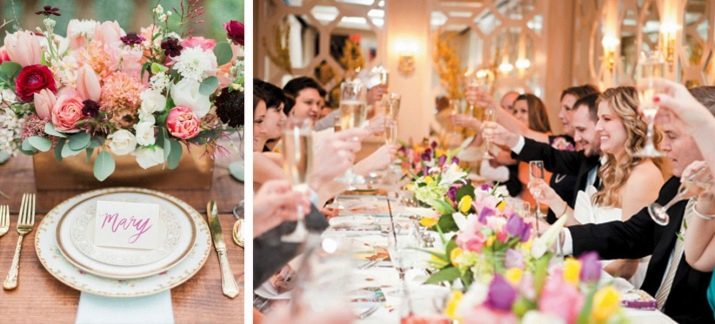
- Divorced couples should be seated away from each other, and each of them should be warned about the presence of the former spouse at the banquet in advance.
- Guests who come alone, should not be planted with couples or companies of old friends. It is better to find such a person the same lonely interlocutor, which, however, often leads to new long-term acquaintances, and possibly to the formation of new relationships.
- An inseparable company of colleagues on the part of the spouse is better to sit next to the same friendly company of friends or classmates on the part of the wife. As a rule, such two teams quickly find a common language and spend time quite fun.
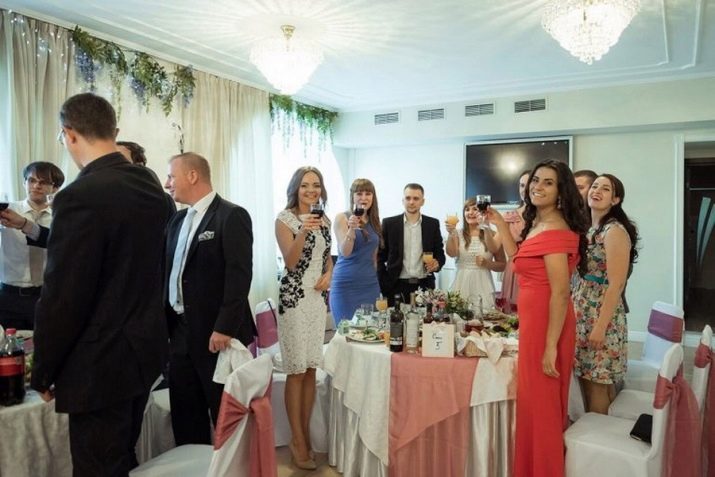
- It is recommended to alternate people with a cheerful and cheerful temperament at the table with shy and calm guests. Otherwise, at some tables there will be stormy fun, and at others, the banquet risks becoming a silent meal. In addition, the interests and hobbies of those present are also desirable to consider.
- Children, if there are more than three of them, are preferably placed at a separate table with food and drinks adapted to their age. This is due to the fact that not all guests are ready to be touched by the presence of young children, and being at the common table of a screaming peanut can cause discomfort to many present. A children’s table is recommended to be kept away from the newlyweds and sound equipment. The latter norm is especially important, as the musical accompaniment of the holiday is often quite loud and can harm the hearing of children.
- It is better to arrange foreign guests with people who speak a little of their native language, or with English-speaking guests.
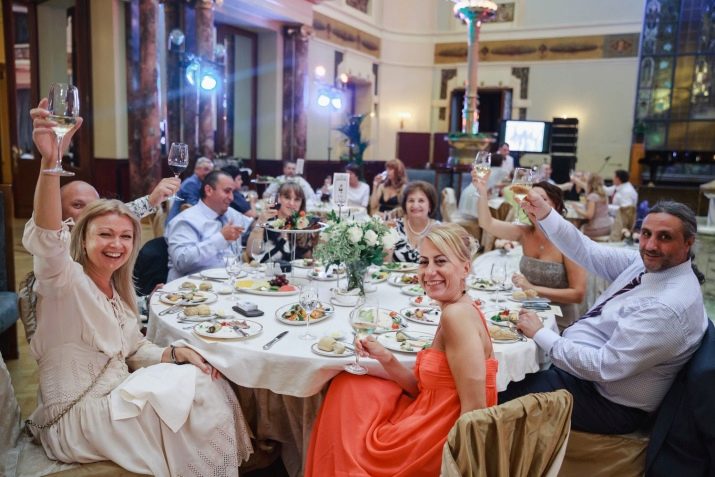
Correct seating of the guests will help to avoid embarrassing and conflict situations and will allow you to spend the holiday in a friendly atmosphere of love and fun
See how to properly seat guests at a wedding in the next video.
